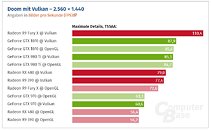Wednesday, July 13th 2016

DOOM with Vulkan Renderer Significantly Faster on AMD GPUs
Over the weekend, Bethesda shipped the much awaited update to "DOOM" which can now take advantage of the Vulkan API. A performance investigation by ComputerBase.de comparing the game's Vulkan renderer to its default OpenGL renderer reveals that Vulkan benefits AMD GPUs far more than it does to NVIDIA ones. At 2560 x 1440, an AMD Radeon R9 Fury X with Vulkan is 25 percent faster than a GeForce GTX 1070 with Vulkan. The R9 Fury X is 15 percent slower than the GTX 1070 with OpenGL renderer on both GPUs. Vulkan increases the R9 Fury X frame-rates over OpenGL by a staggering 52 percent! Similar performance trends were noted with 1080p. Find the review in the link below.
Source:
ComputerBase.de

200 Comments on DOOM with Vulkan Renderer Significantly Faster on AMD GPUs
as i und. ,from original link, async compute didn't worked on amd cards when antialising or TSSAA was used/enabled ;can someone confirm i read it correctly.....my german lacks...
Soooo why would a dev not just build the game in Vulcan to begin with? there is no negative there.
DirectX 12Mantle and also,VulkanMantle.simplified translation:
Bethesda is pointing out, that Asynchronous Compute will only work with AMD's GPUs 1) when no anti-aliasing is being used or 2) when TSSAA is being used instead.
Who bought a Pascal card because now it supports Async? Raise your hands please. Don't be shy.
One more marketing lie from Nvidia. They where going to give Maxwell users Async Compute support through driver updates. Right? Instead, what they did in my opinion, was to prefer to keep that software emulation for Pascal and present it as a new feature. They also didn't used async as the name of that feature, so they don't get probably sued. Instead they used the "Dynamic load balancing" term and let users and tech sites speculate that this is Nvidia's async implementation in Pascal. Finally Pascal was offering async.Well, even with Nvidia's perfect driver optimizations, async could be offering at least 5% more performance to Pascal cards. It doesn't seems to do something like that.
Maxwell's biggest marketing disadvantage was the lack of async support, and they couldn't send Pascal, with a Founders Edition price tag, into the market, without a least the illusion that it supports async. People would have been less willing to pay $700 for just a better Maxwell.
Not the first time that Nvidia is trying to gimp specs, knowing that something like this is influencing the potential buyer's psychology.
Just my opinion of course.
It's standard NV practice.
R9 Fury X users don't feel that let down anymore :P In fact R9 Fury cards in general shine in DX12 and apparently also in Vulkan. While I love my GTX 980 I kinda regret I haven't gone with R9 Fury/Fury X.
Also, for people saying "async emulation", there is no such thing, either you have hardware implementation or you don't. You can't emulate a feature that's sole purpose of it is massive performance boost through seamless connection of graphics and compute tasks. This is the same as emulation of pixel shaders when they became a thing with DirectX 8. Either you had them or you didn't. There were some software emulation techniques, but they were so horrendously slow it just wasn't feasible to use in real-time rendering within games. Async is no different. And NVIDIA apparently doesn't have it. Which kinda sucks when you pay 700+ € for a brand new graphic card...I guess that's how NVIDIA fanboys are comforting themselves after buying super expensive GTX 1000 series graphic card (or GTX 900) that sucks against last generation of AMD cards that weren't particularly awesome even back then. "uh oh it doesn't lose any performance". Well, you also gain none. What's the point then? The whole point of Vulkan/DX12 is to boost performance. When devs will cram more effects into games assuming all these gains, your performance will actually tank where AMD's will remain unchanged. How will you defend NVIDIA then?
FIRST PAGE MATERIAL.
john_ IS DEFENDING NVIDIA.
Are you serious? Read again what I wrote. Damn,....
According to this test done by PC Games Hardware (updated for the 4th time now) a GTX 980 Ti pulls ahead of a GTX 1070 by ~20% (average of the 4 resolutions that have been tested) thanks to Vulkan.
Vulkan really does utilize architectural advantages way better than the OpenGL implementation does. I wonder what kind of performance gains one would see with Vega...
It will be intersting to see if Pascal's faster pre-emption and its dynamic load balancing (which is Nvidia's current answer to async compute) will achieve similar results once ID - with the help of Nvidia - is done implementing it.